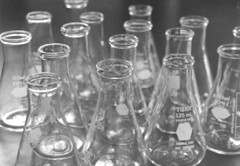This month’s Sierra magazine includes a blurb about some of the lesser known impacts of fossil fuel use & global warming.
Half of the carbon dioxide we’ve put into the atmosphere since 1800 has been absorbed by the world’s oceans, increasing acidity by 30% and changing seawater to carbonic acid. In terms of pH (lower numbers equate to higher acidity), that means a drop of 0.1 from preindustrial levels [8.1] to today’s 8. If trends continue, ocean pH will be 7.7 by the end of the century. At 7.8, however, shell formation ceases. Barnacles, sea snails, and corals will decline precipitously.
In fact, the Caribbean is already impacted, as are sensitive Alaskan waters.
For those of you whom may have forgotten your high school chemistry: Like the Richter scale, pH is logarithmic and each whole number actually corresponds to a ten-fold change in the measured value. Thus the drop from a pH of 8.1 to 8 amounts to the cited 30% increase in acidity, or more specifically a 26% decline in alkalinity.
Carbonic acid is the product of carbon dioxide dissolved in water and it is present in beverages from seltzer to soda pop. Although it is a very mild acid, large quantities of can take their toll, and carbonic acid’s presence in ground water is responsible for the formation of limestone caves. Limestone is of course a sedimentary rock formed from the skeletons and shells of ancient sea-life…
It is interesting to note that since 1976 the EPA has regulated alteration of of pH as a pollutant, permitting variance of 0.2 from normal. This standard has undergone some scrutiny recently, and is likely too lax.

